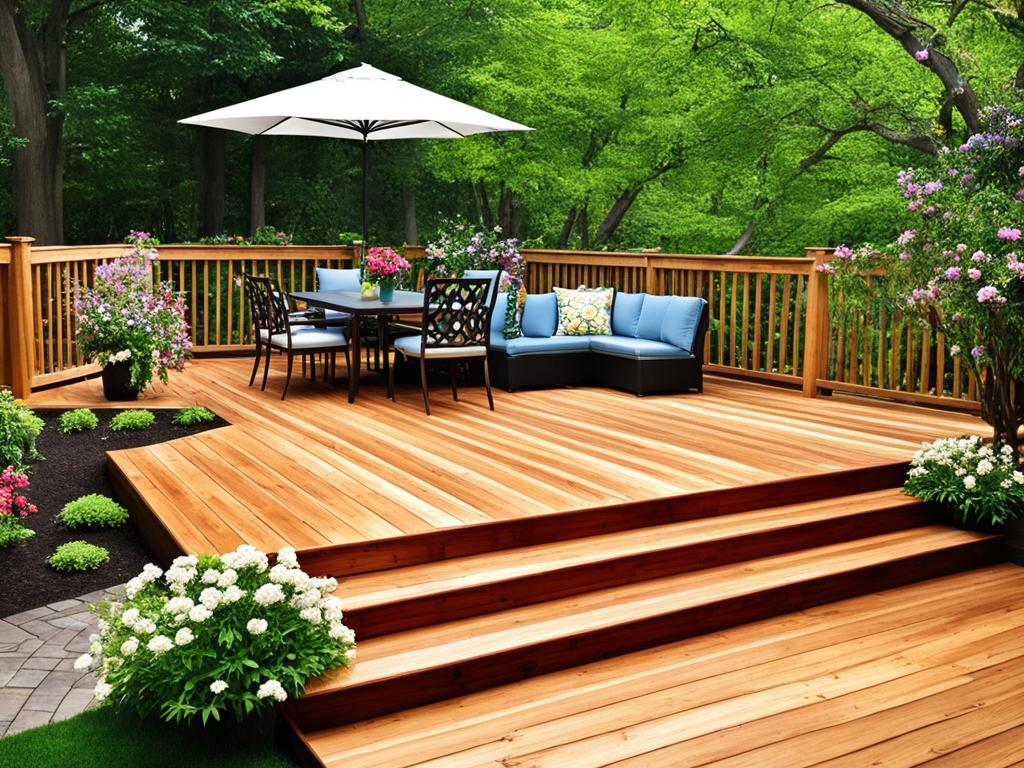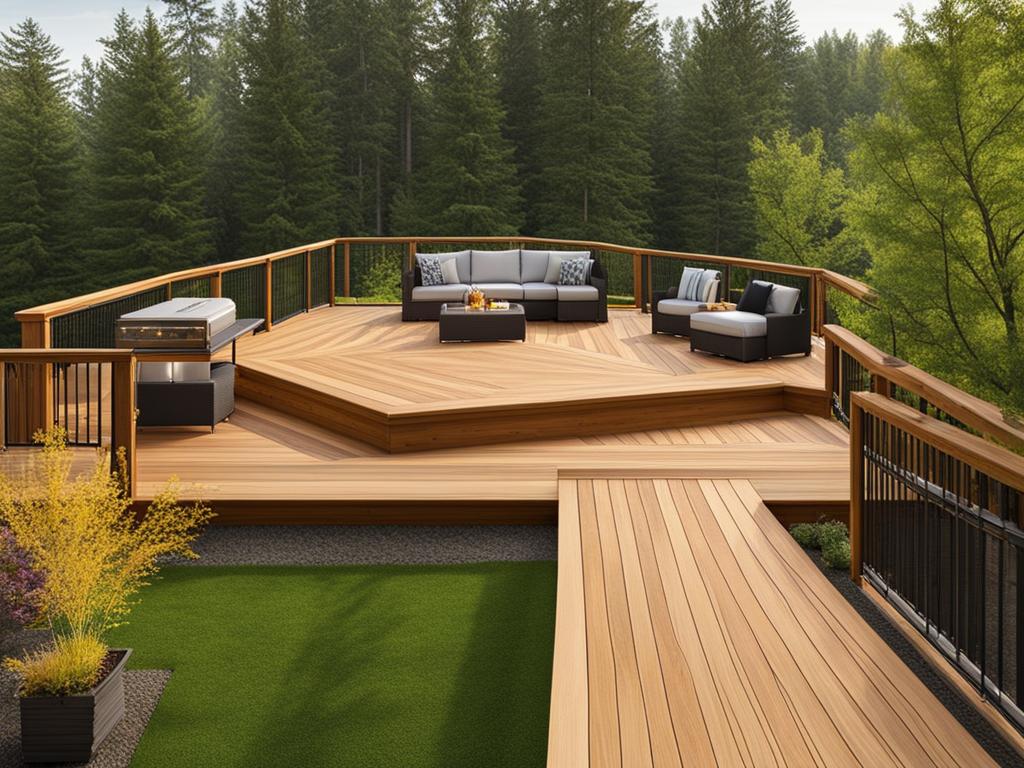When it comes to choosing the best material for a wood deck, homeowners often find themselves torn between cedar and pressure-treated options. Both cedar and pressure-treated wood offer unique qualities that make them popular choices among homeowners. While cedar boasts natural resistance to rot and decay, pressure-treated wood offers affordability and longevity. In this article, we will delve into the benefits, maintenance requirements, and durability of cedar and pressure-treated decks, equipping homeowners with the knowledge they need to make an informed decision.
- Cedar and pressure-treated wood are both popular choices for wood decks
- Cedar decks are naturally resistant to rot and decay
- Pressure-treated decks are more affordable and durable
- Cedar requires regular maintenance, while pressure-treated decks may have a less appealing appearance
- The choice between cedar and pressure-treated wood depends on individual preferences, budget, and desired aesthetic
Benefits of Cedar Decking
Cedar decking offers several benefits that make it a popular choice among homeowners. Firstly, cedar has a natural resistance to rot and decay, making it a durable option for outdoor projects. Its resistance to moisture absorption helps prevent twisting and splitting, resulting in a deck that lies flat and straight. Cedar decks can have a lifespan of 15 to 20 years, although it may deteriorate faster if used for ground-level decks or shaded decks that take longer to dry.
Additionally, cedar decking requires regular cleaning and resealing to retain its color and appearance. Despite the need for maintenance, cedar has a warm and rich look that many homeowners find appealing, making it a popular choice for those who prefer a natural aesthetic.

When properly maintained, cedar decks can maintain their beautiful appearance for years. Regular cleaning with a mild soap and water solution is recommended to remove dirt and debris. It’s important to avoid using harsh chemicals or pressure washers, as they can damage the wood fibers. After cleaning, the deck should be allowed to dry thoroughly before applying a high-quality sealer or stain to protect the wood from UV rays, moisture, and mold.
“Cedar decking offers a natural and timeless beauty that enhances any outdoor space. Its distinct aroma and luxurious appearance create a welcoming atmosphere for family and friends.”
Despite the maintenance requirements, many homeowners choose cedar decking for its eco-friendly nature. Cedar is a renewable resource that is biodegradable and recyclable. Choosing cedar over pressure-treated wood also reduces the environmental impact as cedar doesn’t require chemical treatment, which may contain harmful substances.
In summary, cedar decking provides long-lasting durability, a natural aesthetic, and environmental benefits. While regular maintenance is necessary to preserve its appearance, the warm and rich look of cedar makes it a popular choice for homeowners seeking a timeless and inviting outdoor space.
Advantages of Pressure Treated Deck
When it comes to choosing the right material for your deck, pressure-treated wood offers numerous advantages that make it a popular option among homeowners.
Durability
Pressure-treated wood goes through a treatment process that enhances its durability and resistance to rot, decay, and insect damage. This makes it an excellent choice for outdoor projects, especially for structural components like support posts and joists.
Affordability
Compared to cedar, pressure-treated decking is more budget-friendly, making it an attractive option for homeowners on a tight budget. The cost savings can be significant, allowing you to create a beautiful and functional deck without breaking the bank.
Choosing the Right Pressure-Treated Lumber
It’s important to note that not all pressure-treated lumber is created equal. Cheaper varieties may contain excess moisture, leading to uneven shrinking and twisting as they dry. To avoid these issues and ensure a stable and visually appealing deck, it is recommended to select “choice,” “premium,” or “select” treated boards, which are kiln-dried and have fewer knots and a straighter grain.
Here’s a comparison table to help you understand the key differences between cedar and pressure-treated decking:
| Cedar | Pressure-Treated Wood | |
|---|---|---|
| Resistance to Rot and Decay | High | High |
| Resistance to Insect Damage | High | High |
| Durability | 15-20 years | Varies based on treatment and maintenance |
| Maintenance Requirements | Regular cleaning and resealing | Minimal maintenance |
| Cost | Higher | Lower |
Conclusion
When it comes to choosing between cedar and pressure-treated decks, there is no clear winner. Both materials offer distinct advantages and considerations that homeowners should take into account.
Cedar decking provides a natural and attractive look, along with resistance to rot and decay. However, it requires regular maintenance to preserve its appearance. On the other hand, pressure-treated decking offers durability, affordability, and resistance to insects and decay. It may not have the same visual appeal as cedar, but it can be a practical choice for those on a budget.
Ultimately, the best decking material for each homeowner depends on their individual preferences, budget, and desired aesthetic. It’s crucial to carefully consider these factors and consult with professionals to make an informed decision. Whether you choose cedar or pressure-treated wood, the key is to select the material that will best suit your specific needs and requirements for a long-lasting and enjoyable outdoor space.
FAQ
What are the benefits of cedar decking?
Cedar decking offers a natural look and is resistant to rot and decay. However, it requires regular maintenance to retain its appearance.
What are the advantages of a pressure-treated deck?
Pressure-treated decking is durable and cost-effective. It is highly resistant to rot, decay, and insect damage, but it may have a less appealing appearance.
Which decking material is more durable?
Cedar decking has a lifespan of 15 to 20 years, while pressure-treated wood is highly resistant to rot, decay, and insect damage.
Is cedar deck maintenance-intensive?
Cedar deck requires regular cleaning and resealing to retain its color and appearance.
Which decking material is more affordable?
Pressure-treated wood is generally more affordable compared to cedar decking.
How should I choose the right deck material?
The choice between cedar and pressure-treated wood will depend on individual preferences, budget, and the desired aesthetic for the deck. Consultation with professionals is recommended.
